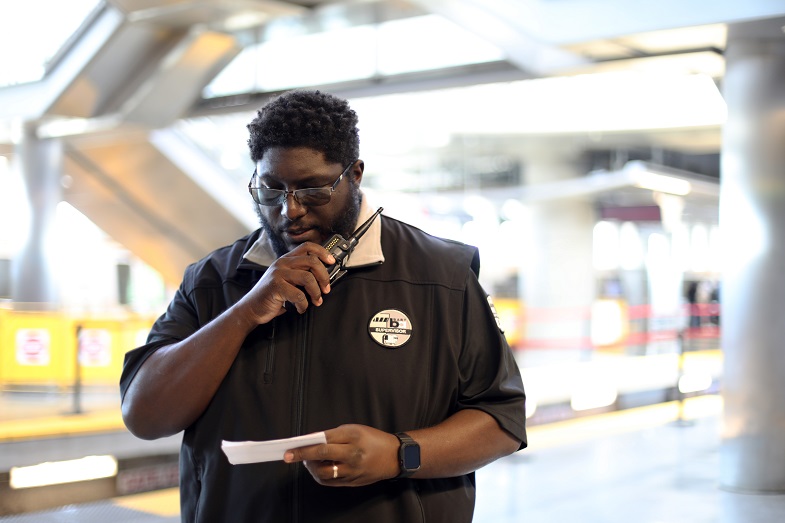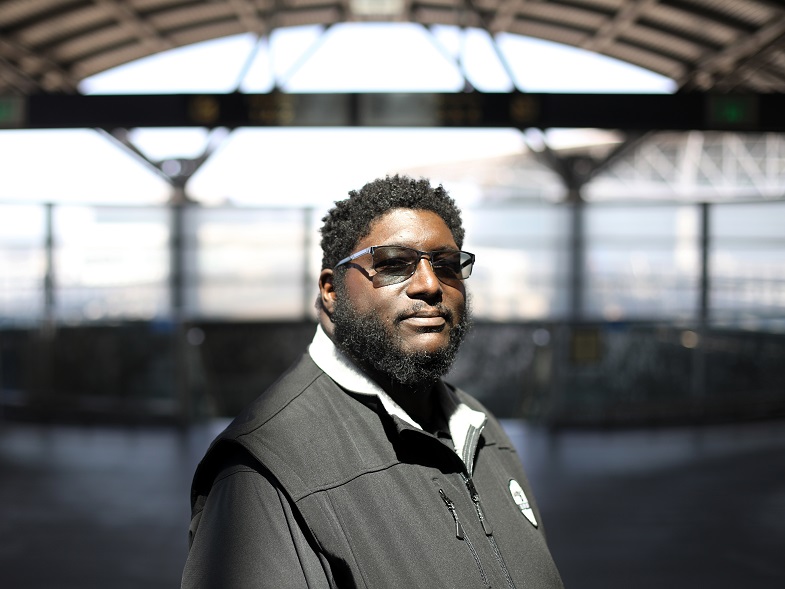Search Results
BART Board President responds to transportation funding proposal
“California’s leadership made a great step today towards helping secure a brighter future for BART, thanks to this robust proposal of dedicated investment in transit,” said BART Board President Rebecca Saltzman. “We thank Governor Brown and our legislative partners for this package, which if passed and signed
BART breaks post-pandemic ridership record
BART set a new post-pandemic ridership record Thursday with 224,721 exits, the highest number since March of 2020.
It was the third day in a row that BART ridership topped 200,000 exits. Ten of the top ten ridership days since the pandemic occurred in September, with weekday ridership remaining robust since Labor Day.
"While our ridership numbers have yet to recover to pre-pandemic levels, these high ridership days are proof that our work to improve the rider experience with the Safe & Clean Plan and other efforts are paying off," said BART General Manager Bob Powers.
This month, ridership was boosted by the Dreamforce conference in San Francisco, the final A’s home games, and concerts and community events, including BARTable partner events like Oakland Pride and the Lafayette Art & Wine Festival.
At the same time, the latest numbers from BART Police show that the number of trains impacted by unwanted behavior has declined since the department boosted the amount of visible safety staff on trains and in stations. Through July of this year, we have seen both violent and property crime down on the system year over year. Overall crime is down 13% even as we’ve experienced this uptick in ridership.
BART Connects: A young woman from East Oakland says she "wouldn't be where I am today" without BART

Erica Mitchell pictured at Coliseum Station.
BART runs like a thread through every stage of Erica Mitchell’s existence. You might say the system map is a tapestry of her life, woven with memories that stretch from childhood to maturity.
Mitchell grew up in East Oakland near Coliseum Station. The trains that departed every which way from the station were “lifelines,” she said, that carried her to novel places, experiences, and possibilities.
“At different points in my life, BART has meant different things to me,” said Mitchell, now 27 and living in San Francisco. “I wouldn’t have been as independent as I was as a kid without BART; I wouldn’t have been able to survive here; and I wouldn’t be where I am today."
In high school, Mitchell said BART was a symbol of freedom and autonomy. Her school was located in Portola Valley, and every morning, Mitchell would ride to Fremont Station then catch a bus to campus. It was a schlep, but during the ride, she found time to think and dream about the life she wanted to have.
Then, as a student at Laney College, Mitchell would travel from her apartment in San Francisco to Lake Merritt Station and walk to campus. On these trips, she timed her makeup routine with the ride; if she hadn't finished applying mascara when the train reached West Oakland Station, she was behind schedule. When she wasn't doing her makeup, she'd stare out the windows and draw the scenes on the other side of the glass.
Before she graduated, Mitchell started working for the Oakland Mayor’s Office. To get to City Hall, she sometimes had to empty a water jug filled with coins in the hopes that she could scrape together enough change to buy her fare to 12th Street/Oakland Station.
Mitchell still takes BART to work. But she also uses it for fun: to get to dance class in the Mission District, to hit the town with friends, or to catch up with her mom back in East Oakland. Mitchell is a self-described “night owl,” and on late nights with pals, she frequently finds herself racing to catch the last BART train. “It’s very Cinderella and her carriage,” she said laughing.

Mitchell has long understood the importance of public transit to the Bay Area, thanks largely to her late father. Before she was born, Mitchell's dad retrieved the cash and coins deposited in BART fare machines. Later, he operated buses for AC Transit. His bus route drove past Mitchell's childhood home, and some days, she and her mom would meet him at the closest stop to give him snacks and hugs.
Those early exposures to public transportation left an impression on Mitchell. Among friends, she is known as the “#1 BART fan,” but she prefers to call herself a “BART babe.”
BART has also connected her to love, she revealed, squirming slightly. The story goes something like this: During her BART rides to Laney College, Mitchell began to notice the same person on her train each morning. Later, she started seeing him in some of her classes.
“I was excited to see him on BART every morning. When else are you going to have uninterrupted time with your crush?” she said. Eventually, Mitchell and her BART crush started dating – “It was a good time while it lasted,” she said with a laugh.
As Mitchell described the BART meet cute, a lightbulb went off in her head. “There should be a dating car – singles only,” she joked. “You could call it Trainder, like the train version of Tinder."
One cannot deny that BART facilitates meaningful connections, she continued in a more serious tone. When public transportation is at its best, she said, it lays the groundwork for an interconnected region, and “that’s conducive to love, to community, to relationships.”
“Transit teaches you how to be in community with others," she said. “And from those interactions, you can learn to be more accepting and curious.”

About the BART Connects Storytelling Series
The BART Connects storytelling series was launched in 2023 to showcase the real people who ride and rely on BART and illustrate the manifold ways the system affects their lives. You can follow the ongoing series at bart.gov/news.
The series grew out of BART's Role in the Region Study, which demonstrates BART’s importance to the Bay Area’s mobility, cultural diversity, environmental and economic sustainability. We conducted a call for stories to hear from our riders and understand what BART means to them. The call was publicized on our website, social media, email blasts, and flyering at stations. More than 300 riders responded, and a selection of respondents who opted-in were interviewed for the BART Connects series.
BART Board begins FY17 Budget Discussion
BART is in the process of developing its Fiscal Year 2017 budget. The Board received its first look at the proposed budget during the April 14 th Board of Directors meeting. Download the presentation here. Watch an archive of the Board meeting. (Click on April 14 th meeting, item 4A) Read the Preliminary
BART provides update on Saturday's computer network failure
Tamar Allen, Assistant General Manager Operations provided the following update to the BART Board of Directors today related to Saturday’s computer problems that prevented trains from being dispatched between 6am-9am: The type of failure that occurred this weekend is very rare. The last time a network switch
BART team wins top prize at international competition
The International Rail Rodeo is a special opportunity for transit agencies to show off their top talent and BART rose to the occasion. In the latest edition of our podcast series “Hidden Tracks: Stories from BART” you’ll meet the BART team that won the overall title at this year’s competition. This is the
Compassion in crisis: BART worker’s quick thinking, empathy help save a life
Senior operations foreworker Curtis Zedd Jr. photographed on July 9, 2021
By MELISSA JORDAN
BART Senior Web Producer
Curtis Zedd Jr., a born-and-bred Oaklander, does hard, physical work as a BART senior operations foreworker, troubleshooting problems on trains, his 6-foot-1 stature giving him a strong and commanding presence when emergencies arise.
And yet, it was his empathetic, compassionate, sensitive side that kicked in recently when he was credited with saving the life of a man having a mental health crisis, for which he received a commendation for outstanding service.
It was June 23 and Zedd had just checked in to start a shift at Millbrae Station. He noticed that two station agents were trying to talk to a man who was standing in the trackway between the running rails (the tracks the train runs on) and the electrified third rail, which powers the train and can be deadly if touched.
Zedd’s quick thinking kicked in and he got on the phone to the Operations Control Center, asking for the rail to the powered down, then he sat down on the edge of the platform, made direct eye contact with the man, and locked in his gaze.

Curtis Zedd Jr. photographed using his radio during a shift at SFO Station on July 9, 2021
“The first thing I said to him was, ‘Is everything OK?’ “ Zedd recalled. “And he said, ‘No, I’m just tired. I’m tired of everything,’ And I asked him to tell me about what was going on with him. He said he’d already told it, that he’d told his whole story. And I said, ‘Well, you haven’t told it to me. Tell me what’s going on.’ “
The man, whom Zedd estimated to be in his late 50s, said he was a homeless veteran. He said he had nowhere to go, no hope, and just wanted “to end it all.”
“I told him that tomorrow would be another day. That he was able to wake up today, and now he would be able to wake up tomorrow and there would be another chance.”
“I just sat with him, and kept listening to his story,” Zedd said. “I told him, ‘This is not the way to go. We can get somebody out here to take you to a place to stay, to get you some help. I told him that he mattered, and also that his actions would affect a lot of people, people who would be hurt, who would be traumatized, by what he was trying to do.”
What’s especially remarkable is that Zedd stepped up even after having seen such traumatic situations already in his career. Many years ago, when he was working as a train operator at BART and just a few months out of training, a woman threw herself in front of his train at Montgomery Station; she survived. In another case a couple of years back on the Warm Springs line, he coaxed another person in crisis off the edge of the platform to safety.
Zedd doesn’t want to be called a hero, and said it was just instinct that kicked in. He went down into the trackway to be closer to the man at Millbrae after the third rail had been de-energized and trains were being held back.
“I told him, ‘Talk to me. You can vent. I’ll listen to whatever you have to say. Let’s just get out of the trackway. And in the end he calmed down.”
BART Police arrived soon and took the man to receive a mental health assessment.
“I’ve been in transit for 20 years, before BART at VTA, and unfortunately you see this in the rail industry, you see people at the end of their rope sometimes,” Zedd said. He has some close friends who were on site at the VTA yard the day of the recent mass shooting. He grieves for them, and for all who have been touched by such tragedies.
“These things affect a lot of us transportation workers,” he said. “It’s something that station agents deal with every day; they’re usually the first people to come into contact with anybody having a mental health crisis.”
“When we see people who are in trouble, who need help, we try to help them. We sympathize with them,” he said.

Curtis Zedd Jr. received a commendation for his outstanding work on June 23, 2021
The job of a BART operations foreworker involves supervising train operators and station agents, in addition to troubleshooting and attending to emergencies. It’s an incredibly stressful job, but Zedd said he loves his work.
“When I clock in, for the 8, or 10, or 12 hours I’m here, I try to have a good attitude,” he said. “I come in and do my job to the best of my ability. We all have a lot of respect back and forth.”
Zedd calls himself a “transit junkie” who has been riding BART all of his 41 years. His earliest BART memory is taking the train as a young boy from Coliseum Station in Oakland to 12th Street/City Center Station for the Christmas parade.
Operations Control Center Manager Shanon Matthews, who put Zedd in for the commendation, said he truly went above and beyond the call of duty. “We got a call from Curtis to de-energize the rail,” she said. “This person was very erratic, and Curtis kept the individual engaged in conversation. He kept him distracted and got him to turn away from the third rail. And he actually talked the guy back up on the platform and calmed the guy down. He was a strong, compassionate presence.”
BART Police Chief Ed Alvarez has recently created a Bureau of Progressive Policing and Community Engagement, which includes social-work-trained Crisis Intervention Specialists; you can find job listings for those positions at www.bart.gov/jobs. Because these crisis-focused workers can’t be in all places at all times, work like that of Curtis Zedd, the station agents who first interacted with the man in crisis at Millbrae, and others like them, are essential to BART, and to the wellbeing of all who use the BART system.
Farmers' market to open at Glen Park BART Station
The Pacific Coast Farmers' Market Association (PCFMA) will open a farmer’s market in the BART Glen Park Station parking lot beginning Sunday, May 15, 2011, and continuing through the end of October. No parking will be allowed in the lot while the market is in operation. This effort is supported and sponsored
“BART has been a really big constant in my life”: Why a South SF local took her grad photos at a BART station
Kiana Leong pictured in her graduation photos at Downtown Berkeley Station. Photos courtesy of Julianne Han. For Kiana Leong, a BART ride is like a yardstick for her life. The South San Francisco local has been riding BART for as long as she can remember. Her earliest memories stem from preschool, when she
BART looking into cause of Saturday's computer network problem
Read the update from Thursday March 14th into the cause of the network problem here. Monday March 11th Update BART staff is waiting for failure analysis results from Cisco to understand the exact cause of a computer network failure on Saturday. Once we understand the exact cause, we can determine next steps